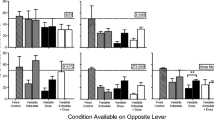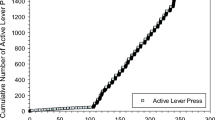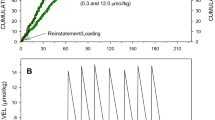Abstract
Under concurrent VI (conc VI) schedules of reinforcement, organisms match the proportion of responses to the proportion of reinforcers obtained from the available options. This result is the basis of the matching law, a major theoretical view of the control of choice between and among available reinforcers. The present experiment examined the extent to which IV cocaine self-administration by monkeys under conc VI schedules of reinforcement was predicted by the matching law. One group of rhesus monkeys (n=4) was prepared with chronic indwelling IV catheters and allowed to respond in a two-lever situation under conc VI schedules of reinforcement for cocaine injections. Three doses of cocaine (0.025, 0.05 and 0.1 mg/kg per injection) were made available under various conc VI schedules with an average inter-injection interval of 3 min. The same injection was available for each response, the difference between the options being the schedule of reinforcement. Each dose and schedule condition was in effect for at least ten consecutive sessions and until responding was stable. In a second group of monkeys (n=3), a comparable experiment was conducted with responding maintained by the delivery of 1-g food pellets. Overall response rate maintained by cocaine was inversely related to dose. In addition, response rate decreased over the course of a session, apparently due to accumulation of cocaine. With regard to choice, more responding was maintained by the schedule that arranged more frequent injections. Choice was well predicted by the matching law, with a consistent tendency toward undermatching but no consistent bias toward one or the other option. Results were similar for behavior maintained by food, though two of three monkeys showed an unexplained bias toward the left lever. With regard to drug self-administration, these results demonstrate that in a choice situation, with all other variables being equal, injections that are available more frequently in time maintain behavior more strongly than less frequently available injections. Undermatching implies that the relative proportion of behavior maintained by the two options is somewhat less than the relative proportion two injections obtained. The finding that choice maintained by cocaine under conc VI schedules was comparable to choice maintained by food extends the generality of the conclusion that drugs and non-drug reinforcers control behavior by similar mechanisms.
Similar content being viewed by others
References
Baum WM (1974) On two types of deviation from the matching law: bias and undermatching. J Exp Anal Behav 22: 231–242
Baum WM (1979) Matching, undermatching and overmatching in studies of choice. J Exp Anal Behav 32: 269–281
Baum WM, Rachlin HC (1969) Choice as time allocation. J Exp Anal Behav 12: 861–874
Bickel WK, DeGrandpre RJ, Hughes JR, Rizzuto P (1992) Behavioral economics of drug self-administration. IV. The effects of response requirement on the consumption of and interaction between concurrently available coffee and cigarettes. Psychopharmacology 107: 211–216
Bickel WT, DeGrandpre RJ, Higgins ST (1995) The behavioral economics of concurrent drug reinforcers: a review and reanalysis of drug self-administration research. Psychopharmacology 118: 250–259
Brownstein AJ, Pliskoff SS (1968) Some effects of relative reinforcement rate and changeover delay in response-independent concurrent schedules of reinforcement. J Exp Anal Behav 11: 683–688
Carroll ME (1985) Concurrent phencyclidine and saccharin access: presentation of an alternative reinforcer reduces drug intake. J Exp Anal Behav 43: 131–144
Carroll ME, Lac ST, Nygaard SL (1989) A concurrently available nondrug reinforcer prevents the acquisition or decreases the maintenance of cocaine-reinforced behavior. Psychopharmacology 97: 23–29
deVilliers P (1977) Choice in concurrent schedules and a quantitative formulation of the law of effect. In: Honig WK, Staddon JER (eds) Handbook of operant behavior. Prentice-Hall, New Jersey, pp 233–287
Findley JD (1958) Preference and switching under concurrent scheduling. J Exp Anal Behav 1: 123–144
Fleshler M, Hoffman HS (1962) A progression for generating variable-interval schedules. J Exp Anal Behav 5: 529–530
Herrnstein RJ (1961) Relative and absolute strength of response as a function of frequency of reinforcement. J Exp Anal Behav 4: 267–272
Herrnstein RJ (1970) On the law of effect. J Exp Anal Behav 13: 243–266
Heyman GM, Oldfather CM (1992) Inelastic preference for ethanol in rats: an analysis of ethanol’s reinforcing effects. Psychol Sci 3: 1–9
Iglauer C, Woods JH (1974) Concurrent performances: reinforcement by different doses of intravenous cocaine in rhesus monkeys. J Exp Anal Behav 22: 179–196
Iglauer C, Llewellyn ME, Woods JH (1976) Concurrent schedules of cocaine injection in rhesus monkeys: dose variations under independent and non-independent variable-interval procedures. Pharmacol Rev 27: 367–383
Johanson CE, Schuster CR (1975) A choice procedure for drug reinforcers: cocaine and methylphenidate in the rhesus monkey. J Pharmacol Exp Ther 193: 676–688
Kelleher RT (1976) Characteristics of behavior maintained by scheduled injections of drugs. Pharmacol Rev 27: 307–323
Keller JV, Gollub LR (1977) Duration and rat of responding as determinants of concurrent responding. J Exp Anal Behav 22: 179–196
Lamas X, Negus, SS, Hall, E, Mello NK (1995) Relationship between the discriminative stimulus effects and plasma concentrations of intramuscular cocaine in rhesus monkeys. Psychopharmacology 121: 331–338
Meisch RA, Lemaire GA (1988) Oral self-administration of pentobarbital by rhesus monkeys: relative reinforcing effects under concurrent fixed-ratio schedules. J Exp Anal Behav 50: 75–86
Nader MA, Woolverton WL (1991) Effects of increasing the magnitude of an alternative reinforcer on drug choice in a discretetrials choice procedure. Psychopharmacology 105: 169–174
Nader MA, Woolverton WL (1992a) Effects of increasing response requirement on choice between cocaine and food in rhesus monkeys. Psychopharmacology 108: 295–300
Nader MA, Woolverton WL (1992b) Further characterization of adjunctive behavior generated by schedules of cocained self-administration. Behav Pharmacol 3: 65–74
Schuster CR, Johanson CE (1981) An analysis of drug-seeking behavior in animals. Neurosci Biobehav Rev 5: 315–323
Shull RL, Pliskoff SS (1967) Changeover delay and concurrent schedules: some effects on relative performance measures. J Exp Anal Behav 10: 517–527
Takahashi M (1994) Concurrent schedule control of monkey’s observing during vigilance. Behav Proc 32: 133–146
Todorov JC, Castro JMO, Hanna ES, Bittencourt de Sa MCN, Barreto MQ (1983) Choice, experience and the generalized matching law. J Exp Anal Behav 40: 99–111
Williams BA (1988) Reinforcement, choice and response strength. In: Atkinson RC, Herrnstein RJ, Lindzey G, Luce RD (eds) Steven’s handbook of experimental psychology, 2nd edn, vol 2: learning and cognition. Wiley, New York, pp 167–244
Author information
Authors and Affiliations
Rights and permissions
About this article
Cite this article
Woolverton, W.L. Intravenous self-administration of cocaine under concurrent VI schedules of reinforcement. Psychopharmacology 127, 195–203 (1996). https://doi.org/10.1007/BF02805994
Received:
Accepted:
Issue Date:
DOI: https://doi.org/10.1007/BF02805994




